TURKISH CHILDREN’S GAMES
Even today Turkey is predominantly rural. Though the intrusion of both indoor and outdoor foreign games such as cards and football has taken away much of the popularity that traditional games and sports once enjoyed, and other games have been lost as a result of the weakening of local cultures, throughout Turkish villages one can still see both adults and children amusing themselves in their leisure with identical games, and these traditional games vary greatly from village to village.1
Since peasants and children are among the most obstinate conservators of traditional usage, the study of their legends, anecdotal material, certain fragmentary meanings and actions, and the rich game vocabulary still extant can help to reveal the connection of many games with primitive forms of ritual and their original functions.
One of the most important aspects of folk games is vocal or verbal expression. Since many folk rhymes are descended from myth-the concomitant and accompaniment of ritual-the study of them may serve to reveal the original function and inherent motivation of the games in which they are sung or recited.
Four main categories of verbal expression may be distinguished in Turkish folk games: songs and chants, rhymes, tongue twisters, and riddles. Songs accompanying games and question-and-answer chants enjoy the greatest popularity among girls. Rhymes are also very rich in Turkish folklore. Generally they are called tekerleme, a word which has several variants and usages. Another verbal element is tongue twisters (yanıltmaç) the rapid recital of which provides much fun. Some games are basically a competition on the speed of recitation. Or they are used as a forfeit, the loser having to recite a tongue twister. Some tongue twisters are repetitive, and rapid repeated recitation changes the sounds into obscene or undesirable words. The last category is asking and answering riddles, which are used as games by themselves either between two competing groups or individual players.2
Another important dimension to be considered is the occasion and functions of the games. As mere amusement, games are performed on a great variety of occasions. Man finds many situations for game-playing, such as birth, puberty, circumcision, marriage, return from military service, and release from prison, to which may be added the religious and national holidays, fairs, seasonal festivals, and ceremonies. There are games for therapeutic purposes. Each region and each town has its indoor and outdoor gatherings and parties held on various occasions, their names and traditions differing from place to place.
Curious Linguistic Similarities Among Game Names:
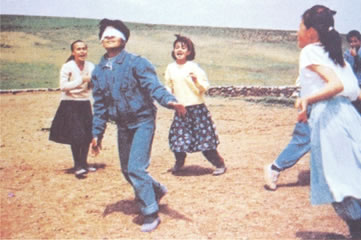
Blind Man, Körebe
Regardless of distance, countries share a common heritage, as can be shown by the wide diffusion of certain games, hence they may contain the memory of a rite of some kind. A good example of this is one kind of Blind Man's Buff from villages in the Ankara and Mugla areas called Kör Çebiş, meaning Blind Goat or Kid; yet in Kırklareli it is called Kör Çapar. (Çapar has various meanings, but the most common is any animal such as a dog which has spots on its skin.) The villagers explain Blind Goat by saying that the blind man is like a goat with its hair falling over its eyes, but it must have a deeper significance since in Europe Blind Man's Buff is called Blind Bock in Sweden, Blinde-buk in Denmark, Blind Bock in some parts of southern Germany, all meaning' 'blind goat." In some parts of Germany it is called Blinde Kuh meaning Blind Cow. When the blindfolded "it" touches another player, he calls out, "He is burnt." We can easily conjecture that this is a survival of a rite in which a priest wearing animal skins seized upon a victim or scapegoat by chance, and the person touched was sacrificed by fire.
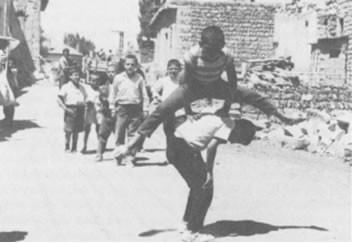
Leap Frog, Birdir Bir
One of the most common names in Turkey for Leapfrog is Uzun Ejek, meaning "long donkey." Not only in some parts of England is it Donkey, Jump the Long Horse, or Jump the Long Mare, but in other countries it has similar names too: in Germany Das lange Ross, in Italy II cavallo lungo, both meaning "long horse," in Belgium it is Le plus fort cheval, "the strongest horse.”
Another game which has many counterparts in Turkey is the one called in English, "Mother, the Cakes are Burning." The mother trusts her children to the charge of a maid, unaware of the danger that a kidnapper is scheming to abduct all the children, who are then transformed into edibles, or sometimes colored birds, and the mother has to identify them. In Germany this is known as De Brei kakt aver and Moder o Moder wo ist Kindken bliewen? and in Sicily Mamma caduta dal monte. There are many similar games in Turkey, one of them from Kütahya is called Dünür Dünür (dünür means an in-law, so the name of the game can be translated as "Mother-in-law, Mother-in-law").
In games where the players do not know whether they are runners or chasers, this is decided by spinning a flat token or stone, one side white and the other black. The side whose color comes uppermost chases the other team. Since the ancient Greeks this has been called Day and Night, in Germany Tag und Nacht and in Italy Giorno e notte, or Black and White as in Austria Schwarz-Weiss. Among other names in Turkey it is called Kırmızı-Beyaz, meaning "Red and White," in Kayseri and Istanbul.
Mangala:
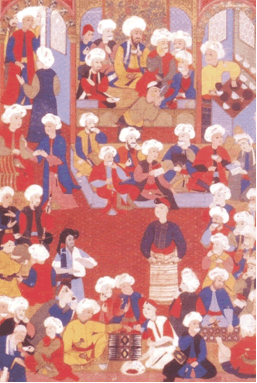 |
| Mangala at Turkish Cafes (16th century) |
A game which is remarkable for its peculiarly wide distribution, especially in Africa, is Mancala (or in Turkish spelling Mangala), though in some countries it has different names. One of the earliest references to Mangala is in The Arabian Nights (fifteenth night). The first reference to it by this name in Turkey is in Thomas Hyde's De Ludis Orientalibus (Oxford, 1694), volume II, in which he gives a list of approximately thirty Turkish games including Mangala. In fact, in current Turkish in some areas like Gaziantep in Southeast Anatolia, this game is still sometimes called Mangala.
The game is generally played in brazier-like holes, either twelve or fourteen of them. In most cases it is played by two players in the following manner. Each player digs seven small holes in the ground in lines opposite each other and places five stones in each hole.
Each player in turns picks up all the stones out of any one hole on his side, and distributes them one by one counter-clockwise in the other holes beginning at the first hole on the right of the one from which he has taken the stones. The game is finished when all fourteen holes are empty. The stones are then replaced five in each hole and the player whose stones exceed the number needed to fill the holes in his line wins.
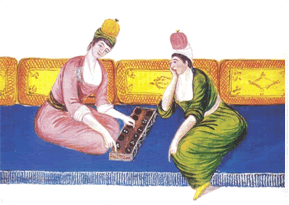 |
|
Two Ottoman Women playing Mangala
(18th century)
|
There is lots of strategy in this game, yet planning cannot be done when the player is playing since the transfer from one hole to another requires very speedy action, so thinking is done when the other player is playing. There are many varieties of Mangala in Turkey, and the purpose in describing this example is to show that a game like Mangala, although separated by race, language,and history-not to mention the thousands of miles between such places as Bali, India, Malaya, Ceylon, the Philippines, Abyssinia, and San Domingo-is very widespread.
Rewards and Penalties:
Another dimension of games is the values assigned to the outcome of the game, that is, rewards and penalties. In many games the loser or the losing group pays a forfeit; this often takes the form of being made to appear ridiculous. For instance, he or she has to stand on a chair and crow like a cock, or bray like a donkey, or have his or her face smeared with paint. Sometimes these penalties become a game played independently. We may call them "victimizing games," where horseplay and jokes are abundant and sometimes the victim is the innocent party who does not know what will happen to him. For instance, in Tokat villages in a game called Dök Dök ("Pour Pour"), somebody hides himself in a place from where he pours a pail of water over the innocent party. In Burdur, in the game called Mahkeme (The Court) they pull the carpet away so that those who are facing trial all fall down. Some games are based on frightening people by dressing up as ghosts. The penalties most used at the end of games are that the loser must imitate a cock, an old woman, a dog, a cat, a mouse, or a bear.
There are penalties not only for losers but also for players who do not observe the rules, who are querulous, or who hesitate. In Çankırı, they lay such a player on the ground where they mark his outline with chalk. After he has stood up, all the other players urinate over this silhouette. In Istanbul, Sinop, and other towns, the other players lift a spoilsport horizontally and bring him down six times with a jerking movement as if his back will hit the ground.
In gambling games the winner seizes the property of the loser, for instance marbles in marble games, or knucklebones in games with these. Penalties can mean a delay in games such as the one called "Slappies," where one player stretches out his hands palm upwards and the other player has to rest his hands flat on top of them, with the backs of his hands uppermost. The player whose hands are underneath tries to slap one or both of the palms before the other withdraws his hand. This game, generally called Kızartmaca ("Making Red") can be painful.
The Objects Used in Games:
The objects used in games and children's toys furnish another aspect of the subject. Toys in the villages are almost unknown except for a few homemade objects. The most common toys in the rural areas of Anatolia are tops. The author has recorded more than seventy names for tops in Anatolia. There are also contest games played with tops. For instance, in a game called Tuka, Dozdoz, or Domuz, one contestant tries to hit the other's spinning top with his own and drive it out of the game area.
Kites fall into two categories: the first are made of cloth or paper but have a wooden frame, and others are without this structure. The names of kites change according to their shape, make, and the various localities. One kind of kite called Çıvga in Çorlu/Tekirdağ (western Anatolia) is in the shape of a funnel which revolves on its axis when hit with a stick. Some of them are made by splitting one end of a stick and inserting two feathers.
Slings and catapults made of leather, knitted cloth, or elastic are very popular. On certain holidays there are real fights which can take a nasty turn between groups with slings, and contestants may be seriously injured. There are popguns or peashooters such as Kutlek and Patlangaç, and waterguns, called Çırtlamık.
Some shoot nails and can be used for shooting birds, or they shoot arrows called Çakmaklı. Traps and birdlime are also abundant for catching birds or other small animals.
Among musical and noisemaking instruments the most common are whistles made of wood, straw, bone, or other material, and some thirty different names of these have been recorded. There are noisemaking rattles such as Vızılık from Erzincan/Kemaliye; it is a small piece of wood with three holes in it. A string is passed through these holes, and when the strings are pulled at both ends the wood piece revolves making a buzzing sound. Şıngırdak from Bolu consists of two nested cylinders which make a noise when shaken. Or Çıngırdak from Isparta is a tin box containing small pebbles which rattle when shaken. Şakıldak from Ordu/Ulubey is made of the bark of trees with hemp hanging from one end. When shaken to and fro, then suddenly shaken strongly back, it makes a sound like a gunshot.
Large playthings like swings, revolving wheels, seesaws, and roundabouts, though primitive, work effectively and efficiently. One kind called Çıkrıncak is very interesting. It works both as seesaw and roundabout. One vertical pole four and one-half meters high has attached to its axis another horizontal pole four meters long. It moves so speedily that some contests are even organized. This device is so widespread that nearly thirty different names have been recorded.
Swings are most popular, and it is a springtime practice, especially for girls, to sing appropriate songs while swinging.
There is also a peculiar toy from Gaziantep called çıkşa, which is a round, flat piece of wood with a groove making it like a spool; a string is wrapped round, and when one end of the string is held letting the spool unwind and drop, it climbs up again itself and will endlessly continue up and down. (Once this toy was a worldwide craze under the name of Yo-Yo.)
GAMES
Knucklebones Games:
Two large categories of games which are most popular in rural Anatolia are the Astragals or knucklebones games (Aşık) , and the Ring game (Yüzük Oyunu). The first is more an outdoor game, yet it can also be played indoors; the latter is more an indoor and table game.
Knucklebones may have six sides, but four sides are more commonly used since they fall in four ways with the flat, concave, convex, or sinuous sides up; hence they are used for gambling instruments serving the purpose of dice. Not only does each of these six sides have dozens of different names according to region, but also different names indicate the way the bones are thrown, the game rules, or the animal from which it is taken.
For instance there is a game called Aşığım, Ne Adam? ("My knucklebone, what sort of a man is he?"). In this game they try to discover a person's nature or character, since each side is called tok (satiated), aç (hungry), alt (donkey) and üst (bey). A similar game can be found in Gaziantep under the name of Aşık Filan Ne Kişi? Sometimes an aşık is cast to start another game, to decide who is going to start first, or to determine "it." A large variety of aşık are used for gambling.
Sometimes a larger knucklebone is added to hit the smaller ones, either to dislodge it or transfer its place according to a borderline. This knucklebone is not only bigger in size but heavier. To make it heavier they pierce it to the hollow inside, which is then filled with molten lead. It is such an old Turkish game that it is mentioned in the tales of Dede Korkut, tales of the Oghuz Turks in Central Asia during the Middle Ages. Aşık also can be used in combination with other games such as an astragal game played by girls in Tekirdag where the player throws her ball up in the air and before it falls down she must pick up as many knucklebones lying on the ground as she can.
There are also guessing games played with knucklebones. For instance, there is a game called Hıcıp from Gaziantep where one player holds a knotted handkerchief while another player hides a knucklebone in the garments of one of the other players, using ruses to bewilder the other players so that no one sees which player he has placed it with. Then all ask "Who has the knucklebone?" The players who cannot guess are beaten with the knotted handkerchief; the one who can guess right can hide the knucklebone next. There is a combination of knucklebone with marbles, again in Gaziantep, in a game called Aşık-Gülle,where knucklebones are hit and dislodged by marbles.
Ring Games:
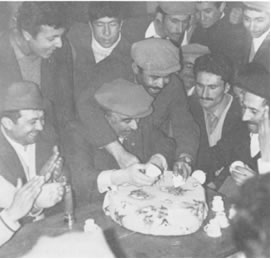
The Ring Game, Yüzük Oyunu
The second very popular category of folk games in Turkey is Yüzük Oyunu (The Ring Game), which is a guessing game. On a tray there are usually eleven coffee cups, one of which covers a ring (or sometimes a seal). There are two teams. The first team hides the ring under one of the inverted cups. Their opponents try to guess the cup under which the ring is hidden. If the opposite team is right with their first guess, it is their game, and the functions are reversed. This is the most important moment of the game, and victories are celebrated with cheers. If they find the ring with the second guess, the hiding side gets eleven points, and the ring is hidden again. If it is not found the first or the second time for each cup upturned, the hiding side adds to its score by adding the number of cups upturned to the eleven points from the lifting of the second cup. This is done until three unopened cups are left. If it is found in the first or the second of these cups, the hiding reverts to the guessing team. If it is not found in these two of the remaining three cups, the hiding team continues the game. Whichever teams gets fifty points first is the winning side. Of course this is a simple description of the game, as there are many more rules, either basic ones about making progress or special ones about “what happens if...”
More than a game, the Ring Game is an institution, where very many beliefs, rhymes, and penalties are involved, and sometimes there is even serious tormenting of the winning team. If the guessing side finds the ring under the first cup, they may give a chance to the other team by hiding the ring under only four cups. If they find it by lifting two cups, the hiding ones lose eleven points; if they find the ring in the other, then the hiding ones lose twenty-one points. If they cannot find it in the third cup, they lose twentyone points. The number of cups, scores, and rules vary according to regions.
Ring games are not always played with cups. Sometimes the ring is hidden in the hand, or under hats, towels, or handkerchiefs. When it is hidden in hands, the ring is threaded on a long circle of string and the players sit in a circle, holding the string with both hands. In the middle of the circle is the "it." When the game starts the players stretch their fists to both sides in order to touch the fists of the players on either side. Holding their hands thus, they transfer the ring secretly from hand to hand quickly, and "it" in the middle, by studying the hands and faces, tries to spot who actually holds the ring. If the ring is thus discovered, then the one who had it changes place with the one who was in the middle. Sometimes instead of a ring a reel is used. The general name for this ring game is Cicoz.
Ball Games:
Anatolian ball games are also very rich in number and kind. One is the favorite game of girls. The ball is tossed up, and before it falls down a certain action is done; or the ball is thrown and is accompanied by a count or rhyme which must finish before the ball touches the ground.
Another kind is a combination of a ball game with a racing game. Instead of touching by hand, a ball is thrown to the next runner. Or, the players of one team mount the players of the other team piggyback and they throw the ball to each other. If the ball falls to the ground or if it is caught by "it," then the teams reverse their roles. Another kind of ball game is throwing balls into holes dug in the ground.
For instance, in the Emenli (emen means "hole") Top from Çorum (Central Anatolia), the number of holes exceeds the number of players by one. The ball is thrown from a distance of four or five meters. If the ball enters the hole of another player, then the thrower mounts on his back. If the ball enters the extra hole called the hole of the Jinn (cin emeni) the others run, and the "it" throws the ball at the runners. If the thrower hits one, he becomes "it."
In some ball games, instead of a hole the target is a goal. In Maraş (Southeast Anatolia) this goal is called hınt. Sometimes it is a large piece of stone called Say. One team stands next to this stone; the other team throws the ball to them. If the ball is caught by the other team before it touches the ground, then the thrower is out; if the team catches it after it touches the ground, they hit the stone with it and the thrower is out again.
There is one interesting game called Çindilli from Konya (Central Anatolia) where the game played is like football, but instead of a ball a worn-out hat is used. In this game "it" tries to guard the hat with his feet and the others try to move it to a place further away. If "it" can get the ball which he has lost and hit one of the players with it, then the one who is hit becomes "it."
There are ball games with sticks, clubs, or bats, mallets as used in pallmall, croquet, golf, and polo. For instance, in Malatya (Southeast Anatolia) in a game called Egir, there is a well one-half meter wide called Tandur: a ball about the size of an orange is hit with a stick eighty to ninety centimeters long, one end of which is bent by heating so that this club looks like a polo stick. The aim of the game is to drive the ball into the hole with one stroke.
In a game called Col from Bitlis/Ahlat (eastern Anatolia) teams try to make goals against the opposite team by hitting the ball with a stick. Instead of balls, in some places bones, knucklebones, cows' hoofs, stones, cypress cones, and other things are used.
Stick Games:
The most widespread of stick games is Jirid. In some games with sticks the purpose is to throw the stick like a javelin as far as possible, or to make it penetrate the ground. In other games penetrating the ground is not sufficient; it must also hit a previously placed stick.
A very widespread game with sticks is called Çelik Çomak, though there are dozens of other names according to the region, with slight changes of rules. A Çelik is a small fairly thick piece of wood about a foot long, with each end pointed round off into a point. A longer stronger stick of three to four feet is called Çomak. A long narrow hole approximately two feet long, six inches wide, and three inches deep is dug in the ground. The Çelik is placed across it; one man raises the Çelik with his Çomak and sends it afield with a stroke and the other player tries to catch or touch it. If he succeeds in doing so, he gets possession of the hole and starts playing the game. If he fails, then the man who first sent the Çelik avails himself of the first chance.
The game has some resemblance to cricket, in which one side bats and the other bowls. When defending the hole the “batsman” tries to hit the Çelik away with the stick, and every time he hits it he counts a point in his favor. In a variant of this game one player sends the Çelik as far as he can, then he starts measuring with his stick the distance between the hole and the place where the Çelik has fallen. According to region he requires so many units of this stick in all to win the game. A few of the many other names for Çelik are düllük, şibibik, for hole çıldır, mene, yalak, güllük and for the çomak, holla.
Nearly fifty different kinds of çelik-çomak have been recorded. Sometimes sticks are thrown like a javelin to hit a target-usually a heap of stone or bricks; sometimes the players try to hit a target while they are running. Or a target may be a melon or pumpkin on a pole. Some games are played by sliding javelins along the ground.
Stones and Pebbles Games:
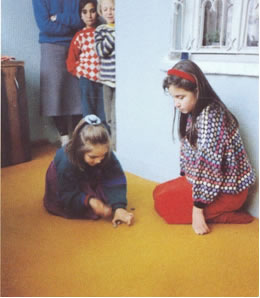 |
| Five Stones, Beş Taş |
There is a large variety of games with stones and pebbles in Anatolia. Some are a kind of warfare, with two teams throwing stones at each other, either with slings or hands. On occasion this results in very dangerous consequences, but some beliefs encourage this dangerous game. For instance, in Kayseri (Central Anatolia), if Dağ Döğüşü (stone war) is not played, that year the crops will not be abundant.
In some games big heavy stones are thrown as far as possible, and in other stone games a larger stone is used as a target and they try to hit it with their smaller stones. Or players make a mark on the ground and throw their flat stones at it aiming to get nearest to the mark.
Alternatively, there may be small objects piled at the target, and whoever gets nearest to the greatest number of the scattered objects wins.
In another kind "it" has his stone in a hole, and others throw their stones trying to knock the stone out of the hole; when the stone is knocked out, if he can catch the one who has dislodged his stone, "it" is replaced.
Another stone game favorite with girls which requires skill and quickness is called Beş Taş (Five Stones). In the palm of her hand each girl holds five small round stones which she tosses in the air and tries to catch on the back of the hand. When four stones have fallen on the ground, one is retained in the hand and then tossed up. While it is in the air, with the same hand, she must grab the four stones that are on the ground and catch the one tossed before it reaches the ground. Then one stone is again tossed in the air and the four stones on the ground are grabbed one by one, each grab being preceded by the tossing and catching of a stone that is retained in the hand. This is repeated, grabbing two by two, then three and one, and then all together.
Yet another kind is mill, merelles, morris; a kind of board game. A rectangle is chalked on the pavement and divided into four squares by lines drawn parallel to the sides from the center of one side to that of the other. Standing at a fixed distance the players each take three stones, and each plays, in turn, with the object of placing his stones in a straight line. If a stone is between two belonging to an opponent it may not be moved and is considered blocked. This is called Üç Taş (Three Stones) like Three Man Morris or Merrymen. The other kind, more like Nine Men's Morris, is similar, with the object of getting three stones in a line; it is called Dokuz Taş (Nine Stones) or Dokurcun. The origin of the Turkish game probably goes back to the Kirghiz, Kazak, and Uzbek tribes of Central Asia, where spreading nine stones called Kumalak was used in fortune-telling and divination.
The Six Man Morris known in Britain and other countries seems to have been unknown in Turkey. Space does not allow description of all categories of games, but nearly all the standard games are played by Anatolian peasants, including marble games; games with buttons, hazel nuts, beads, or seeds and other implements; chasing games; catching games; hide-and-seek games; hunting games; guessing games; daring and exerting games; acting games; and dramatic games. All these categories are played throughout Anatolia under different names. Their rules and regulations vary from place to place, as do their names, but in essence they are the same everywhere. In short, Anatolian games are a rich field of study not only for students of folklore, but also for linguists, since game terminology is very rich and varied.
1 Only two studies on Turkish games are in English: M. Hasluck, “Traditional Games of the Turks," Jubilee Congress of the Folk-Lore Society (London, 1930), pp. 137-159, and P. G. Brewster, “A Sampling of Games from Turkey," East and West [Rome], 11:1 (1960), 15-20. The present article is drawn either from my own fieldwork or from personal experience as a child, a father, a teacher, or simply as a Turk, as is my published study of Anatolian Turkish games Oyun ve Bügü (Istanbul: Iş Bankasi Kültür Yayinlari, 1974).
2 On the function of Turkish riddles as a game and contest, see İlhan Başgöz,"Functions of Turkish Riddles," Journal of the Folklore Institute, 2 (1965), 132-147.
* Excerpted with permission of the author from: Some Notes on Aspects and Functions of Turkish Folk Games, Metin And, The Journal of American Folklore, Vol. 92, No. 363. (Jan. - Mar., 1979), pp. 44-64.








